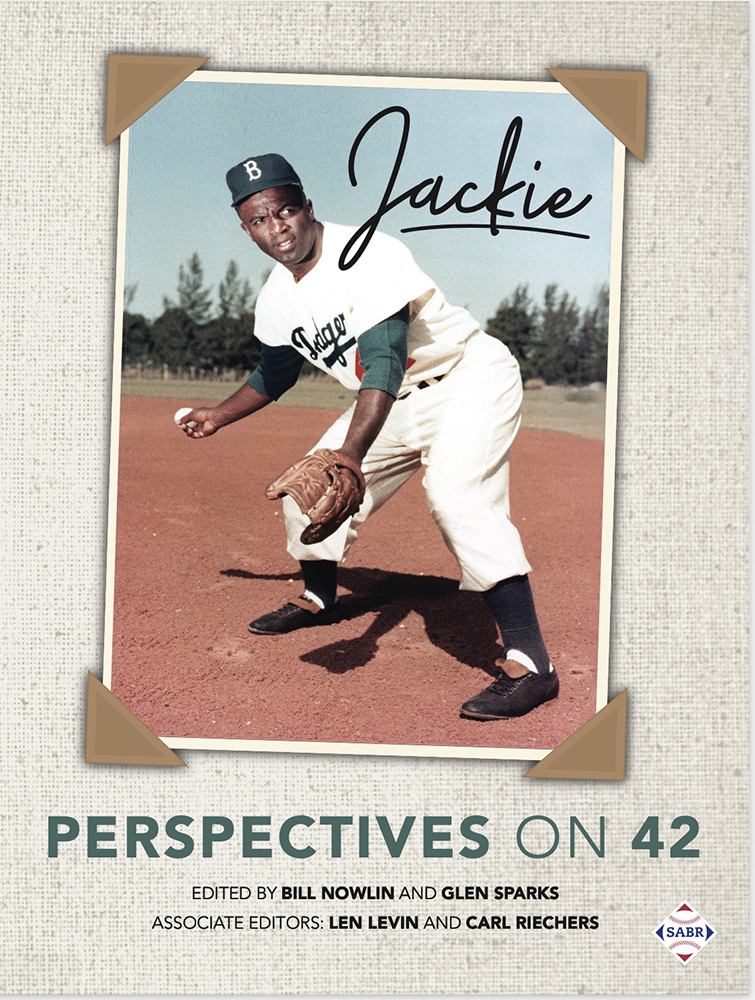Introduction: Jackie: Perspectives on 42
This article was written by Bill Nowlin - Glen Sparks
This article was published in Jackie Robinson: Perspectives on 42 (2021)
 No one can doubt the immense courage shown by Jackie Robinson when he took his position at first base at Ebbets Field on Tuesday afternoon, April 15, 1947. The first play of the game was a groundball to third base, a throw across the diamond to Robinson at first base, and the first putout of the game.
No one can doubt the immense courage shown by Jackie Robinson when he took his position at first base at Ebbets Field on Tuesday afternoon, April 15, 1947. The first play of the game was a groundball to third base, a throw across the diamond to Robinson at first base, and the first putout of the game.
It wasn’t just the one moment, of course, but the ongoing import of what his presence on the field meant. Robinson was the first Black American to play what was then defined as major-league baseball at a time when baseball was dominant in American culture – truly the national pastime, but an institution that had been segregated by race.
Challenges to racism have always been fraught with peril. A generation later, Rev. Martin Luther King was shot and killed as he stood on a hotel-room balcony in Memphis. He was one among many who have lost their lives in the struggle for civil rights. More than 50 years later, and nearly 75 years after Robinson’s debut, Black citizens of the United States still suffer discrimination and obstacles and still find their very lives more in danger than do many of their fellow Americans.
To be a pioneer in 1947 required bravery. In some respects, baseball led the way to a more integrated society. Even after Jackie Robinson’s debut, however, it took 12 more years before every one of the 16 teams in the American and National Leagues integrated. Robinson had by then completed his 10-year Hall of Fame playing career. The six-time All-Star with a lifetime batting average of .309 and an on-base percentage of .409 has baseball statistics that rightly place him in Cooperstown. He won the first Rookie of the Year Award and, two years later, the National League Most Valuable Player honor. Robinson played on six pennant winners and in the World Series in 1955.
Perhaps it is true that celebrating Jackie Robinson’s courageous role in integration can sometimes reduce him to a symbol, and oversimplify his grappling with the complex racial issues of his day, allowing him to become a convenient and self-congratulatory icon celebrated by Major League Baseball today. But, in fact, he was – and remains – an important symbol, and a very meaningful and inspirational one. Certainly, there are myths related to Jackie Robinson. That comes with legend.
There is no question that there was another side to his breaking the color barrier, to be followed by Larry Doby and others. There was gain, but there was loss as well: the vibrant Negro Leagues lasted only a very few more years after that.
Our thought in assembling this book was not to take a particular tack, or drive any narrative, but simply to collect a number of articles and essays that appreciate various aspects of the life and accomplishments of Jackie Robinson.
Almost all of the articles in this book were written for the book. Some 54 members of the Society for American Baseball Research (SABR) took time out as SABR begins to turn 50 and contributed their work as authors and editors to bring together a book appreciating the career and the life of this exceptional man.
BILL NOWLIN wishes the Red Sox had signed Jackie Robinson when they could have back in 1945. Born in Boston that very year, he has been a Red Sox fan since he can remember. He has been active with SABR since helping host the Boston convention in 2002 and on the board of directors since 2004. As a volunteer with SABR, he has helped edit several dozen books and over 1,000 research articles.
GLEN SPARKS has contributed to several SABR books and is completing a biography of Hall of Fame shortstop Pee Wee Reese for McFarland & Co. He has a journalism degree from the University of Missouri.


